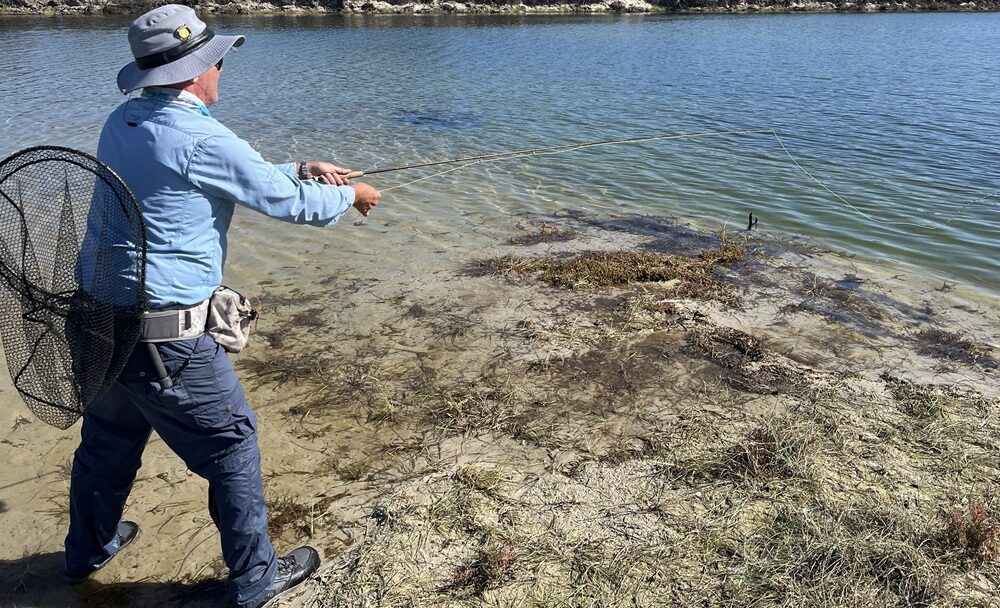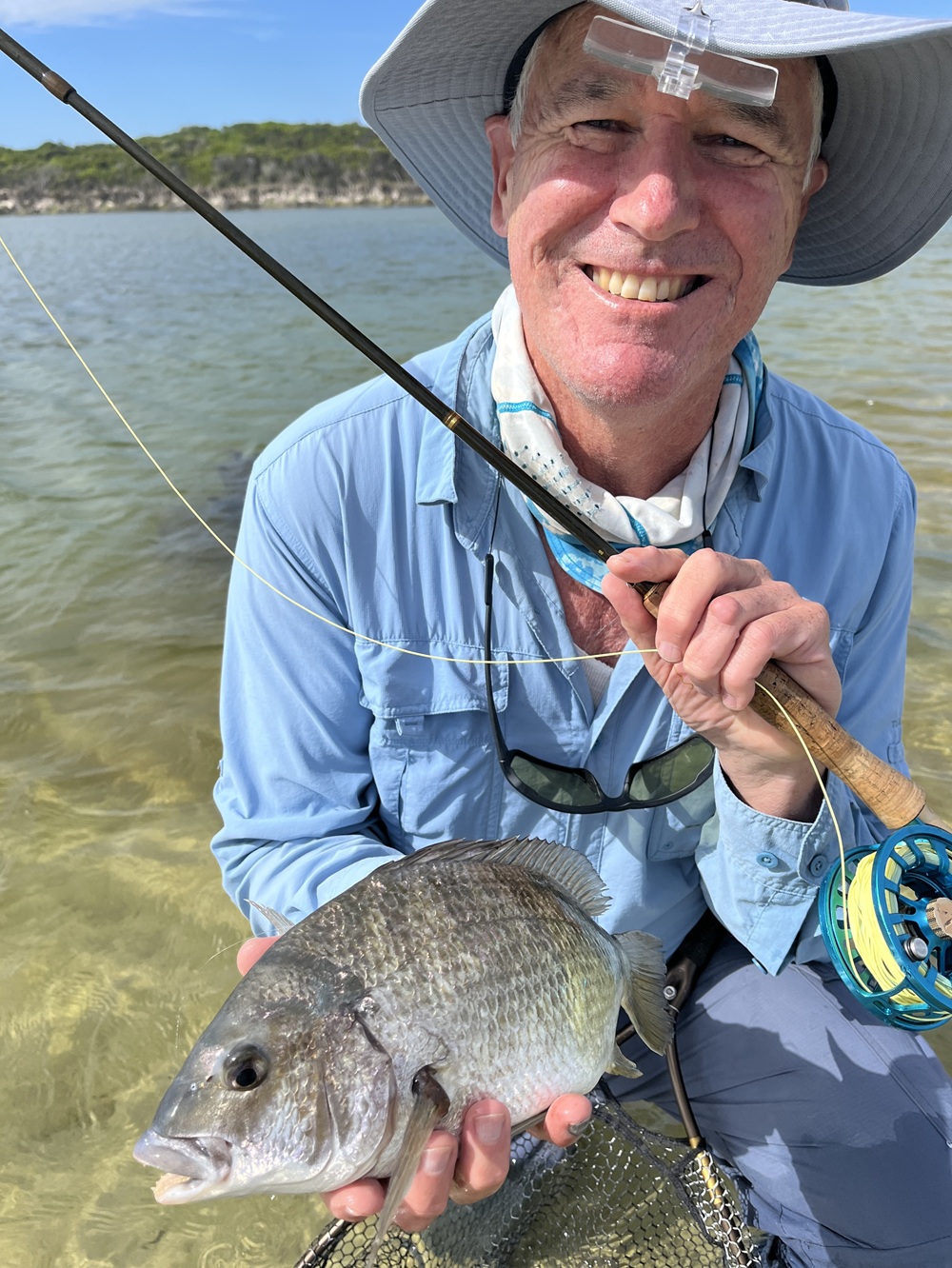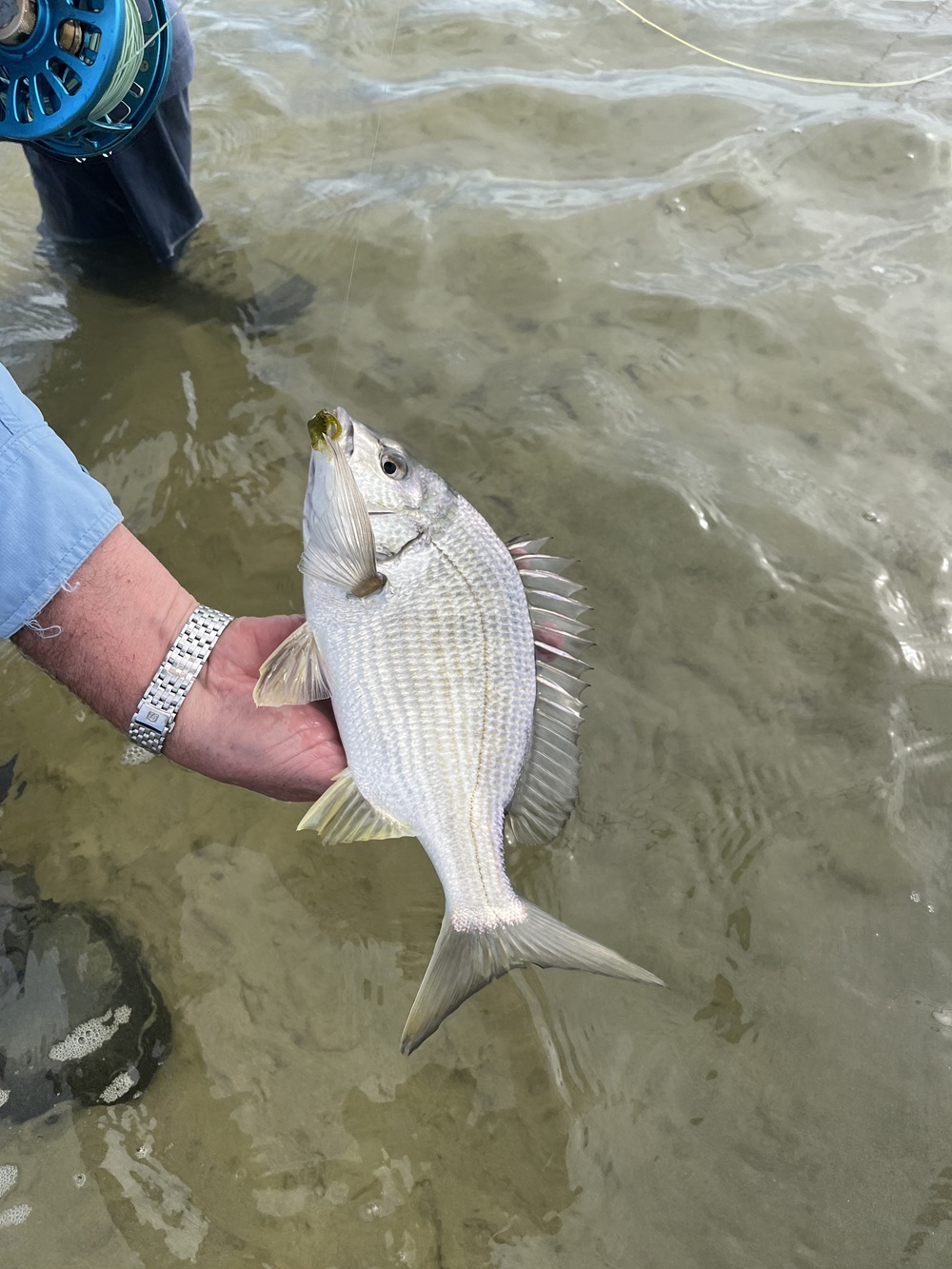
Looking back, I did everything wrong. When we first arrived at the estuary of the mighty Glenelg River, my mate went left and, despite him having more recent experience than me, I went right. I fished a completely new technique to me using an Oros indicator and really didn’t know what I was doing. As darkness approached, I got a bit cold having been wet wading, while my mate was snug in his breathable waders. So, I decided to change into dry clothes and cast from a jetty while my mate waded along some bullrushes, catching another half a dozen EPs, while I caught nothing. When he went small, I went big, almost playing Tattslotto, hoping to encounter a mulloway – a fish for which the Glenelg is famous.
After dark and a pub meal, we went back to the water where Smarty immediately caught another lovely bream and another handful of estuary perch. My most significant catch was an overhead power wire on which I broke off my fly, losing half my leader. I didn’t even see the sign attached to the nearby pole which promised instant death if the wire were to be touched by an expensive graphite rod. My head-torch wasn’t holding securely around my forehead, so I found myself in the undignified position of not being able to direct the beam of light at the point of focus in front of my glasses as I failed to tie on another length of tippet.

Another EP to Smarty!
In the end, my mate feigned fish-catching sufficiency and insisted that I use his rod. At which point I immediately caught a modest EP before we decided to call it a day.
Of course, it’s amazing what a good night’s sleep and some retrospective reflection can do, isn’t it? The next morning, I was full of questions. What leader length? (At least 3.5 metres.) Mono or fluoro? (Fluoro, don’t be stupid!) How thin? (2X to start with then 3X because the water is super clear.) How are you retrieving the fly? (30cm definite strips, three to five in a row, then stop for a second or so. Then repeat unpredictably. As Craig Coltman would say, move the fly enough that you can pause it.) What weight in the fly? (Just enough to sink it and allow it to flutter rather than plummet down.) Who’s going to win the upcoming election? (No answer, he was in the zone.)
We headed back to the estuary where we had fished the previous afternoon, this time with the sun shining conveniently over our shoulders as we walked along slowly. Within minutes, Smarty announced he had seen a bream. A few minutes later, he said there was a whole school more or less under his rod tip, just over the drop-off. At this point, I decided I needed to be more like a limpet on a rock, or a barbed fly stuck in his vest. When my buddy looked right, I looked right. When he looked left, I looked left. When he breathed in, I breathed in. Interestingly enough, after peering into the blue depths for some minutes, a strange thing happened – I saw a bream too. Then another, then another as they ghosted their way along the bottom.

So that’s what I’m looking for.
I would like to be able to report that when I could actually see the fish, this was a game changer. Well, it was as far as the secret ingredient, confidence, was concerned. However, I still couldn’t get the fly into the optimal position even to my satisfaction, let alone to that of the fish.
In the meantime, my mate was getting the occasional eat and even broke off on one when a fish headed in one direction and he struck in the opposite. But the main thing was that there were fish nearby.
What do you do when you know there are fish close and you aren’t doing any good? You have a choice. You either change the way you are fishing a bit to match the conditions in front of you, or you change the conditions to match the kind of fishing you are doing.
‘Hey,’ came a call from the other side of a small bay I was fishing when I had temporarily let my mate stray more than a rod’s length from me. ‘There are hundreds of bream over here. Come on over.’ I pretty much ran across the water to join him.
He was right, too. There were indeed plenty of fish cruising over the sandy bottom. Even I could see them.

My mate proceeded to catch a number and miss a number. My ledger was still empty. Pushing pride aside, I went and had a look at the fly my mate was using and shamelessly replicated it from the hundreds of choices in my fly box. There were still plenty of fish within easy casting distance, so with uncharacteristic discipline, I false cast away from my target area before changing direction and shooting the fly where I wanted it to land. A little later, a second strange thing happened – a bream jumped on. Of course, I was delighted. Almost as much as my long-suffering mate.

Hooray! Do I look pleased? You betcha!
You would think I had cracked the code, wouldn’t you? That the glass ceiling had been broken and there was only open sky above me. Enormous success clearly lay ahead. Instead, gradually over the next 30 minutes or so of casting near fish, I came to the reluctant conclusion that I was still not in the zone. Catching one outlier does not mean you are there yet.
So, I decided to swing in some trouty logic. I wondered whether I was getting down deep enough, or if indeed I was getting down too deep. You know as a trouty that if the river has a good flow and you are wondering if you are getting down enough, you tie on a heavy nymph with an unweighted nymph behind it. The heavier fly gets the second one down to depth, and the second unweighted fly is able to act in a very natural way, responding to all the unseen variables of current. Often, the fish take the unweighted fly.
That’s why I decided to tie on a second unweighted BMS a metre behind. There were bazillions of minnows around and, like a true trouty, I definitely wanted to match the hatch.
Was this a gamechanger? Hell yes. Immediately the fish started to respond. Most of the time they took the fly on the pause. Sometimes they swooped in from the side, me strip-striking and stumbling backwards in a completely undignified manner to ensure that I was striking into solid fish, rather than into solid bowed line. Sometimes on resuming a strip after a pause, there would be a bit or weight. I decided that too long a pause was disadvantageous, as I imagined the fish had often picked the fly up off the bottom and already rejected it if I was too slow. If my strips were too slow, there was no chance of pinning a fish which had picked up the fly as it either fluttered down, or sat momentarily inert on the bottom.

One of many to the game-changing tandem rig.
‘Hey, Smarty, what fly are you using?’ yelled out Smarty 20 minutes later after a number of fish had been caught.
It was only a matter of seconds before the two of us were fishing the same technique, getting to the right depth, and hooking fish regularly – including some double hookups. We were both in the slot. Bliss!











